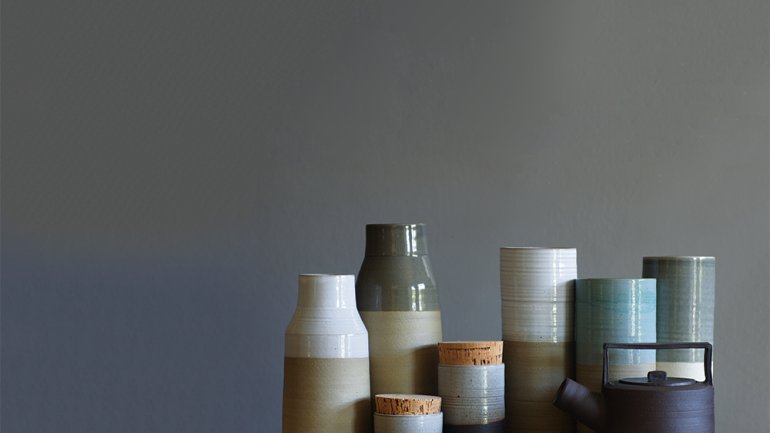Pure Form
Pure Form
Shelley Martin came to clay as an architecture student, in a course spotlighting structure and shape. It was the sole ceramics offering in her department, so after taking it several times for sheer pleasure, she decided to investigate a class in the school’s art department.
“It was so different. I thought, ‘What are you guys making? Why are you doing all this decorating?’ ” Martin recalls with a laugh.
What had drawn her to clay in the School of Architecture and Design at Virginia Tech was a different approach, one that captivated her and hasn’t let go.
“We focused on the pure form, devoid of decoration,” says Martin, who earned a bachelor’s degree in architecture in 2001. “We were studying things like Greek vessels and ancient pottery. It’s so reflective of my work now.”
Martin, whose business is called Vitrifiedstudio, describes her home and kitchen stoneware and porcelain pieces as “minimal modern.” Plates, vessels, bowls, mugs, and other functional items share basic designs, exacting lines, and subtle glazes, gently stating their presence rather than noisily declaring it.
Martin’s transition from architect to ceramist began in earnest in 2011, a few years after she and her architect husband moved from Brooklyn to Portland, Oregon, largely in search of more space.
“Ever since college, I had stayed in love with [clay] and identified as a potter, but in reality I didn’t have the space or time to do it.”
The couple renovated their garage to incorporate a ceramics studio, and she dove in. Even so, the architect didn’t embrace ceramics full time until 2014.
“I was always afraid of losing my day job, because everybody said you can’t make a living doing pottery,” she says. “Even when the numbers went in favor of pottery, I was afraid of jumping in. Then I thought, ‘Look, I’m already in.’ ”
Her aesthetic and a desire for efficient production techniques go hand in hand, she says. “When I design the pieces, I think of cohesion and efficiency, like I’ve created a language,” she says. “It’s important to me that everything stay in the same language, whether it’s a cup, vase, or bowl. Not every pot I’m ever going to make will have the same language, but I want each line to have that consistency.”
Martin has designed her work so that it doesn’t need to be trimmed. She wants to minimize clay scraps, because wedging – kneading the clay to release air bubbles and prepare it for reuse – aggravates her tendinitis and carpal tunnel syndrome. The scraps she does produce she gives to other artists.
Trimming is “one of those things people told me you have to do, but I wanted to make my own rules,” she says. “I love straight lines from architecture. So with the design, I wanted to think of something I could throw and just take off the wheel.”
She sells work online, through stores, and at art fairs. She also sells dinnerware sets directly to restaurants and, on her Etsy shop, sells her personalized cups, jars, and cremation urns.
Martin is glad customers connect with her spare style.
“There are a lot of people out there who, like me, love super-simple,” she says. “They don’t want extra decoration or adornment.”
While much of Martin’s work is on the smaller side, she loves the challenge of making larger objects, such as oversized bowls and vessels.
“I think that’s from working in the scale of houses and big buildings,” she says. “Smaller things are nice, but I also like ‘big statement’ pieces that influence the environment and change the room.”
Diane Daniel is a writer who splits her time between Florida and the Netherlands.

